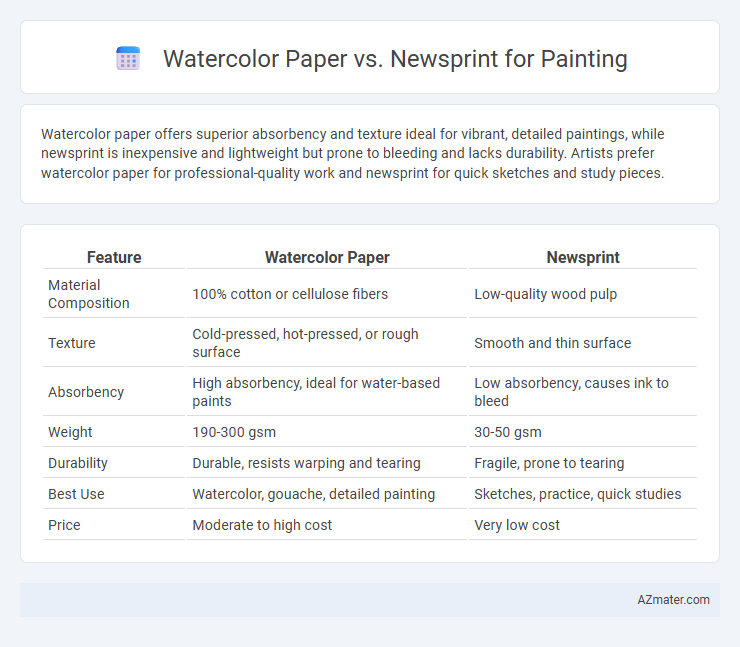Watercolor paper offers superior absorbency and texture ideal for vibrant, detailed paintings, while newsprint is inexpensive and lightweight but prone to bleeding and lacks durability. Artists prefer watercolor paper for professional-quality work and newsprint for quick sketches and study pieces.
Table of Comparison
| Feature | Watercolor Paper | Newsprint |
|---|---|---|
| Material Composition | 100% cotton or cellulose fibers | Low-quality wood pulp |
| Texture | Cold-pressed, hot-pressed, or rough surface | Smooth and thin surface |
| Absorbency | High absorbency, ideal for water-based paints | Low absorbency, causes ink to bleed |
| Weight | 190-300 gsm | 30-50 gsm |
| Durability | Durable, resists warping and tearing | Fragile, prone to tearing |
| Best Use | Watercolor, gouache, detailed painting | Sketches, practice, quick studies |
| Price | Moderate to high cost | Very low cost |
Introduction to Painting Surfaces
Watercolor paper features a textured surface designed to hold water and pigment effectively, preventing warping and allowing for vibrant color blending. Newsprint is a lightweight, smooth paper that absorbs paint quickly but lacks durability and archival quality, making it suitable mainly for practice sketches rather than finished artwork. Choosing the right painting surface impacts paint absorption, texture, and overall artwork longevity, with watercolor paper preferred for professional-quality water paintings.
What Is Watercolor Paper?
Watercolor paper is specifically designed to handle the water and pigment used in watercolor painting, featuring high absorbency and a textured surface that prevents warping and enables vibrant color retention. Made from 100% cotton or cellulose fibers, it offers durability and strength, distinguishing it from newsprint, which is thin, low-quality paper prone to buckling and bleeding. The heavyweight composition of watercolor paper supports multiple washes and detailed techniques, making it essential for professional and amateur watercolor artists.
What Is Newsprint Paper?
Newsprint paper is a low-cost, lightweight paper primarily made from wood pulp, designed for temporary use in newspapers and sketches. Unlike watercolor paper, which is thick and textured to absorb water without warping, newsprint lacks the durability and absorbency needed for wet media, causing paint to bleed and paper to easily buckle. Artists typically use newsprint for quick studies or practice sketches rather than finished watercolor paintings.
Texture and Surface Differences
Watercolor paper features a textured surface with a higher absorption capacity, allowing for vibrant color retention and detailed brushwork, while newsprint has a smooth, lightweight surface unsuitable for wet media due to its tendency to buckle and tear. The roughness of watercolor paper provides better paint adherence and layering, enhancing pigment intensity and blending capabilities, whereas newsprint's lack of texture results in poor control and color absorption. Artists often prefer watercolor paper for its durability and ability to handle multiple wash layers, contrasting with newsprint's fragility and limited use for practice sketches or preliminary concepts.
Absorbency and Paint Compatibility
Watercolor paper excels in absorbency due to its textured surface and thick composition, allowing it to hold multiple layers of water-based paint without warping or bleeding. Newsprint, being thin and smooth, absorbs water unevenly, causing paint to pool or feather, making it less compatible with watercolor techniques. Artists seeking vibrant color retention and controlled blending benefit from watercolor paper's superior absorbency and paint compatibility.
Durability and Longevity
Watercolor paper offers superior durability and longevity due to its high-quality fibers, often made from 100% cotton, which resist warping and withstand multiple washes. Newsprint, composed of low-cost wood pulp, lacks archival qualities and deteriorates quickly, yellowing and becoming brittle over time. Artists aiming for preservation and lasting artwork typically prefer watercolor paper to ensure their paintings remain vibrant and intact for decades.
Cost Comparison
Watercolor paper typically costs between $0.50 to $3 per sheet depending on quality and brand, offering durability and texture that supports water-based mediums without warping. Newsprint is significantly cheaper, often less than $0.10 per sheet, making it an economical choice for practice or sketches but lacking the archival quality and absorbency needed for finished watercolor artworks. Investing in watercolor paper provides better longevity and color vibrancy, justifying higher costs for serious painting projects.
Ideal Uses for Watercolor Paper
Watercolor paper is ideal for techniques requiring heavy washes, layering, and detailed brushwork due to its absorbent, textured surface that prevents warping and uneven pigment distribution. Artists often choose hot-pressed or cold-pressed watercolor paper for preserving vibrant colors and enhancing the longevity of paintings. Unlike newsprint, which is thin, highly absorbent, and prone to bleed-through, watercolor paper supports professional watercolor methods and archival-quality artwork.
When to Choose Newsprint for Painting
Newsprint is ideal for preliminary sketches, practice sessions, and quick studies due to its low cost and lightweight, making it less suitable for detailed or long-lasting works. Artists choose newsprint when experimenting with composition or testing color schemes, as it absorbs paint differently compared to watercolor paper, often resulting in softer edges and less control. Its tendency to warp or deteriorate quickly under heavy washes means newsprint is best reserved for practice rather than final artwork.
Final Recommendations: Which Paper to Use?
Watercolor paper offers superior texture, absorbency, and durability, making it ideal for vibrant, detailed watercolor paintings that require layering and washes. Newsprint, with its smooth surface and low cost, is suitable for quick sketches and practice but is prone to bleed-through and deterioration over time. For final artwork, prioritize high-quality, acid-free watercolor paper to ensure longevity and color fidelity.

Infographic: Watercolor paper vs Newsprint for Painting
 azmater.com
azmater.com